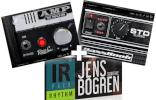Vangelis
![]()
Liste tres complete de son equipement:
Akai S900 Photo in "Direct"-booklet
Akai S1000 "S.O.S." July 1990 (UK)
Akai S1100 Keyboard Review interview, dec '92 (UK)
Akai DD1000 Keyboard Review interview, dec '92 (UK)
Alesis SR-16 Seen on picture of Vangelis at his keys at the Vangelis Odyssey website.
ARP 2500 One cabinet in the Musical Express broadcast.
Arp Odyssey Superstar LP ("Earth" re-release, photo around '80)
Arp Pro Soloist Photo
Bosendorfer grand piano Oor '76 article
Crumar Compakt Piano Oor '76 article
Elka Rhapsody 610 Sound on Sound "Recording Vangelis" equipment list
Ems Vocoder Superstar LP ("Earth")
Emu E4X Sampler Amonst Vangelis' gear at the Mythodea concert, 2001
Emu Emulator 1 Photo in "Superstar"
Emu Emulator 2 Photo in "Direct"-booklet
Emu Proteus/2 Gear at the Mythodea concert, 2001
Ensoniq VFX-SD ET1 TV interview 1990
Ensoniq Mirage Seen on pictures of Nemo studio
Farfisa Synthorchestra Sound on Sound "Recording Vangelis" equipment list
Fender 88 Oor '76 article
Hammond B3 Oor '76 article
Hohner Clavinet Oor '76 article
Korg 01W/FD Recognized preset sound in "1492"
Korg 700 monophonic Interview Keyboard '84
Korg 800DV "Maxi Korg" inside cover of Heaven and Hell LP
Korg DSM1 "S.O.S." July 1990 (UK)
Korg DVP1 Photo in "Direct"-booklet
Korg i3 Spotted at Athletics opening ceremony '97
Korg Karma Preset rhythm: Ending of World Cup Anthem Synth version
Korg M1 French Musicien magazine
Korg M1R Module (or M1REX) Gear at the Mythodea concert, 2001
Korg Poly 800 Sound on Sound "Recording Vangelis" equipment list
Korg Polyphonic Ensemble Japanese LP pressing
Korg PS-3300 Spotted in a video interview
Korg S1 Spotted in the Conquest of Paradise music video
Korg Symphony French Musicien magazine
Korg T1 Eureka concert (TV)
Korg T2 "Antigone de Sophocle" extract in Musiques au coeur (TV)
Korg T3 "Musiques au Coeur" (TV)
Korg Trinity Preset sounds in Oceanic
Korg Triton Preset sound in Mythodea Introduction
Korg x3 Spotted at Athletics opening ceremony '97
Korg Wavestation Spotted in repairshop in Paris
Kurzweil 250 French Musicien magazine
Kurzweil K1200 Spotted at Athletics opening ceremony '97
Kurzweil K2000 "Musiques au Coeur" (TV)
Linn LM1 Keyboard interview '81
Moog Minimoog keyboard interview'81
Moog Modular System Booklet of 3LP box
Moog Satelite Sound on Sound "Recording Vangelis" equipment list
Oberheim 2 Voice Odes LP
Oberheim Matrix 12 Photo (in Keyboard?)
Roland CR 5000 Keyboard interview '81
Roland D50 French "Musicien magazine"
Roland JD800 Eureka concert (TV)
Roland Jupiter 4 (JP-4) Sound on Sound "Recording Vangelis" equipment list
Roland Jupiter 6 (JP-6) Seen on Herrod Atticus concert photographs
Roland JV1080 or XP-50 or XP-80? Preset sounds in Ask the Mountains
Roland JV80 Keyboard Review interview '92
Roland JX8P Spotted in Nemo studios on photographs
Roland Juno 106 There are two of them on the "Sound Studios" photographs in the "Direct" booklet
Roland MKS 20 French Musicien magazine
Roland MKS 70 French Musicien magazine
Roland MKS 80 Super Jupiter Photo in "Direct"-booklet
Roland MPG 80 programmer for MKS 80 Nemo studio photographs
Roland Paraphonic 505 Photo in People magazine in '82
Roland Promars Photo in "Superstar LP" (Earth)
Roland RE-201 Sound on Sound "Recording Vangelis" equipment list
Roland S-50 French Musicien magazine
Roland S-760 Sampler Gear at the Mythodea concert, 2001
Roland S-770 Keyboard Review interview '92
Roland SH-3A Sound on Sound "Recording Vangelis" equipment list
Roland SH-1000 Sound on Sound "Recording Vangelis" equipment list
Roland SH-101 Spotted in Antarctica DVD extra feature
Roland Super JD-990 Gear at the Mythodea concert, 2001
Roland Super JV-1080 Gear at the Mythodea concert, 2001
Roland System 100 French "guitarre et Clavier" magazine
Roland System 700 modular Pictures in booklet of 3LP box
Roland TR-626 Sound on Sound "Recording Vangelis" equipment list
Roland U110 French Musicien magazine
Roland Vocoder Plus VP-330 Mark 1 Picture in "Electronics and Music Maker" magazine
Roland Vocoder Plus VP-330 Mark 2 Pictures from Nemo studios on web-site
RSF Kobol Keyboard USA interview
Sequential Circuits Prophet 5 Keyboard interview '81
Sequential Circuits Prophet VS (rackmount) Photo in "DIRECT"-booklet
Sequential Circuits Prophet 10 Photo in "Direct"-booklet
Simmons SDSV Keyboard interview '81
Stylophone 350s Mentioned in Oor Feb '76 article
Tornado "Reed" organ Oor '76 article
Theremin Radio interview "Walhalla"
Waldorf Microwave Keyboard Review interview '92
Yamaha CP-80 Sound on Sound "Recording Vangelis" equipment list
Yamaha CS-40M Keyboard interview '81
Yamaha CS-80 Keyboard interview '81
Yamaha DX7 Photo in "Direct"-booklet
Yamaha TX7 On pictures from inside Nemo studios
Yamaha DX7 II Photo in "Direct"-booklet
Yamaha DX21 Seen on TV news item in mid eighties
Yamaha EMT100 French Musicien magazine
Yamaha GS1 Photo in SOS interview , Dec 84
Yamaha GS2 Keyboard interview '81
Yamaha RX5 Rev. cymbals in Sidestreets, and on "Direct" photo under papers
Yamaha SY77 Foto in the City Booklet
Yamaha SY99 Sounds heard on Voices (chimes in Prelude)
Yamaha VL1 Patches recognized on Voices and Oceanic
Zyklus Midi Performance System Sequencer used on albums like Direct, inspired the custom "Direct box"
Et un lien qui explique quel materiel a ete utilise et sur quel album:
http://news.planetorigo.com/ar(...)h0mp&
